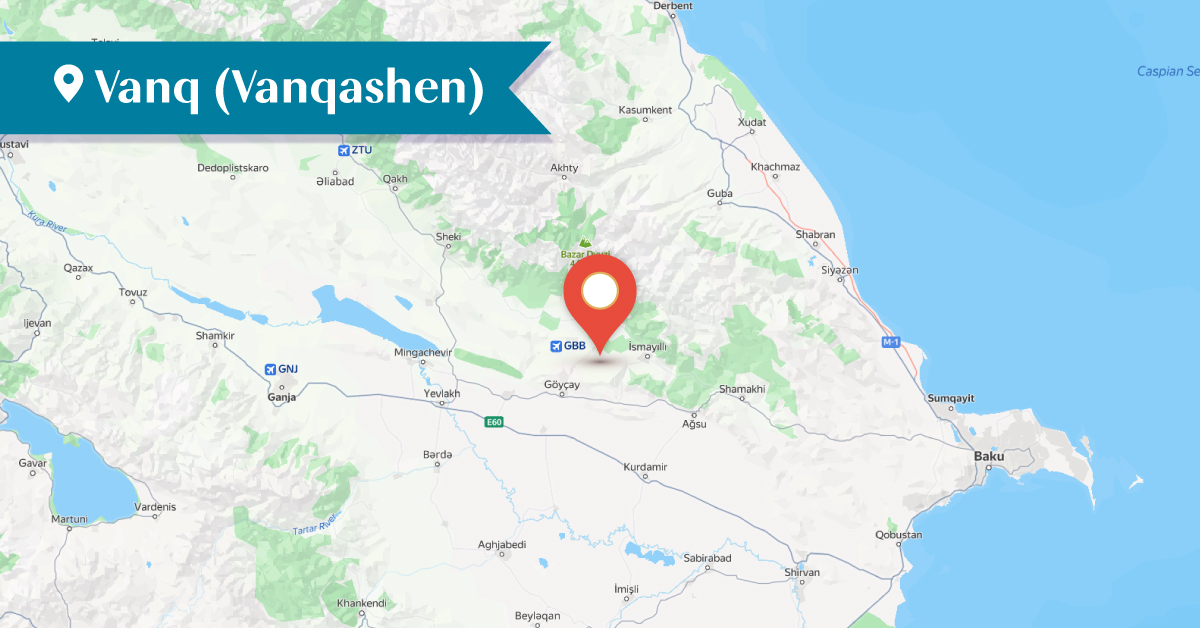2025
2025
2025-07-14

The Vanq village in the Ismayilli district is located 20 km west of the district center. Vanq was one of the ancient settlements of the Shamakhi district. Due to being a monastic property, the village was named Vanq or Vanqashen. The ancestors of its inhabitants migrated from the village of Vank in the Khachen district of Artsakh, as well as from the Jraberd district, and Ashan, Nngi, Chartar villages.
During the visit of the prominent ecclesiastical figure and researcher Archbishop Sargis Jalalyants in the mid-19th century, there were 60 Armenian households in Vanq. In 1861, the village had 140 Armenian households. By the time of the visit of Bishop Makar Barkhudaryants in 1886, the village had 182 Armenian households with a population of 1,033. In 1914, the village was entirely inhabited by Armenians, with a population of 1,131.
In the summer of 1918, Vanq was attacked by Turkish troops and local Tatars. Armenians from Vanq and approximately 10 nearby villages, numbering 10,000–12,000 people, organized a four-day heroic self-defense. In August 1918, the Armenian population of Vanq was subjected to a brutal massacre by Turkish forces.
After the establishment of Soviet rule in Azerbaijan, some of the surviving Vanq residents returned to their native village. By 1924, there were 19 Armenian households in Vanq, with 60 inhabitants. A primary school existed in the village, which was closed in the 1950s.
In the 1960s, the local authorities established a separate neighborhood adjacent to the village for Azerbaijanis relocated from Soviet Armenia. After this, the Armenian population of Vanq gradually began to leave their ancestral village. Lezgins settled in the homes of the emigrated Armenians.
By 1985, only 12 Armenian households remained in Vanq, and they were forcibly deported in December 1988.
In the old neighbourhood of the village stood the church of Surb Hovhannes, which was already in ruins when visited by monument specialist Samvel Karapetyan in 1985. According to the construction inscription, the church was built in 1826:
“The Church of Surb Hovhannes is in memory of Ter Abraham,
son of Grigor, year 1826, Gabala.”
In the northwestern part of Vanq, in the old cemetery, around 200 tombstones dating from the 18th to 20th centuries were still preserved during Karapetyan’s visit. Burials there continued up until the 1988 deportation.
The oldest tombstones in the cemetery date back to the early 18th century:
“This is the tomb of Harut, son of..., year 1718.”
In the Vanq cemetery the tombstone of Prince Petros Yuzbashyan was preserved, with the following inscription:
"This is the tomb of Prince Petros,
Brave son of the Yuzbashyan lineage,
Inspired son of Mother Armenia,
Crowned by the king with the knightly cross.
The good memory of his brave name
Will remain unforgettable in the hearts of Armenians.
Passed away at a venerable age
On September 13, 1859."
Another noteworthy tombstone was that of knight Rustam Arakelyants, who died in 1860:
“This is the tomb of Cavalier Rustam, son of Petros Arakelyants, died 1860.”
In the surroundings of Vanq, ruins of Averak Monastery and the former villages of Shaqlu (or Shaqulu), the archaeological site of Karmir qerts, the sacred site of the Martyrs, and the ruins of the city-site of Jivanshirapat have been preserved.
The village is now called Veng (Azerbaijani: Vəng) and is inhabited by Azerbaijanis and Lezgins.
Bibliography
Barkhutaryants M., Land of Aghvank and its Neighbors: Artsakh, Yerevan, 1999.
Karapetyan S., The Armenian Lapidary Inscriptions of Aghvank Proper, Yerevan, 1997.
Karapetyan, S., Aghvank Proper, Part 1, Yerevan, 2024, pp. 178-191.
Jalalyants S., A Trip to Great Armenia, Part B, Tbilisi, 1858, p. 389.